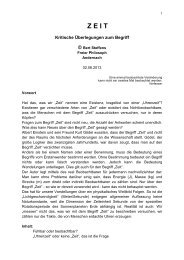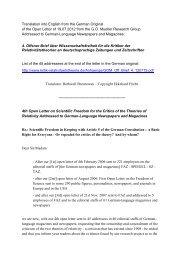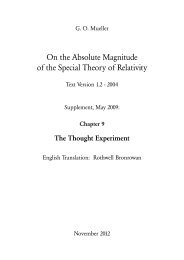2394 weitere kritische Veröffentlichungen - Kritische Stimmen zur ...
2394 weitere kritische Veröffentlichungen - Kritische Stimmen zur ...
2394 weitere kritische Veröffentlichungen - Kritische Stimmen zur ...
Sie wollen auch ein ePaper? Erhöhen Sie die Reichweite Ihrer Titel.
YUMPU macht aus Druck-PDFs automatisch weboptimierte ePaper, die Google liebt.
den können. Jammer kommt zu dem Ergebnis (S. 229-<br />
230):<br />
"If Einstein's thought-experiment was designed to<br />
verify the quantitative result that the length of each rod<br />
decreases in the ratio [alpha], then the velocities of the<br />
two rods had to be equal (in absolute value), a requirement<br />
which necessitates the use of clocks. To take<br />
refuge to a dynamical principle such as the principle of<br />
action and reaction (two equal masses at the ends of a<br />
compressed spring which is being released) would involve<br />
a vicious circle (to verify that the masses are equal<br />
we have to measure, perhaps by the same experimental<br />
arrangement, their relative velocities, cf. Mach's determination<br />
of mass [59]; but to measure a velocity requires<br />
a clock, in fact, two synchronized clocks)." Wenn Einsteins<br />
Experiment dagegen nur das qualitative Ergebnis<br />
hätte beweisen sollen, hätte man keine Uhr dafür<br />
benötigt. Dieses Problem wurde in den 40er Jahren<br />
Gegenstand einer Kontroverse zwischen H. Dingle und<br />
P. S. Epstein, die zu keinem Ergebnis führte.<br />
Gibt abschließend ein "correct assessment of the<br />
of relativistic length contraction> (S. 231-<br />
235). Bezieht sich hierzu auf Differenzierungen der<br />
Synchronisierungsverfahren nach B. Ellis und P. Bowman<br />
(1967), die in dem Faktor [epsilon] ausgedrückt<br />
werden (S. 234): "As we see, the length contraction<br />
factor depends on [epsilon] as well as on the direction<br />
of motion. In fact, it can be shown that for a suitable<br />
choice of [epsilon] the factor can be made larger than 1<br />
leading to a length dilatation rather than to a length<br />
contraction."<br />
Jánossy, Lajos 1957<br />
Further considerations concerning the physical interpretation<br />
of Lorentz's transformations (in russ. Sprache?).<br />
In: Uspekhi fizicheskih nauk. 62. 1957, S. 149-181.<br />
Status: Kandidat. - Quelle: Smulsky 1992 (New<br />
approach).<br />
Jánossy, Lajos 1963<br />
A relativitáselmélet filozófiai problémái: [Philosophische<br />
Probleme der Relativitätstheorie] / Jánossy Lajos,<br />
Elek Tibor. - Budapest: Akad. Kiadó 1963. 351 S.<br />
Status: Kandidat. - Quelle: GBV.<br />
Jarbeau, Paul 2003<br />
E [ungleich] mc²: [datiert: 7.4.03] / Paul Jarbeau.<br />
In: The general science journal. 2003 =<br />
http://wbabin.net/physics/jarbeau.pdf - 3 S.<br />
SRT. LORTF.<br />
S. 1: "At the heart of Einstein's 'Relativity: The Special<br />
and General Theory' is the 'Derivation of the Lorentz<br />
Transformation'. This paper shows the basis for this<br />
transformation is wrong. Since Lorentz's is wrong then<br />
Einstein's theory is deeply flawed. - Lorentz uses x =<br />
ct to define the X-axis, and then uses x = -ct to define<br />
the X-axis. This is wrong."<br />
Jefimenko, Oleg D. 1999<br />
Does special relativity prohibit superluminal velocities?<br />
/ Oleg D. Jefimenko.<br />
In: Instantaneous action at a distance in modern<br />
physics: pro and contra. Ed.: A. E. Chubykalo, N. V. Pope,<br />
R. Smirnov-Rueda. Commack, NY. 1999, S. 35-44.<br />
SRT. C-S. ZD. LK. V-ADDIT. FERNW.<br />
Behauptet nicht, die Existenz von "action at a distance"<br />
(im <strong>weitere</strong>n als instantane Fernwirkung bezeichnet, kurz:<br />
Fernwirkung) zu beweisen, sondern nur die Vereinbarkeit<br />
der Fernwirkung mit Albert Einsteins SRT, entgegen<br />
dessen eigener Aussage von der Unmöglichkeit supraluminarer<br />
Geschwindigkeiten. - Erreicht die behauptete<br />
Vereinbarkeit durch eine massive, geradezu vernichtende<br />
Kritik der SRT: bestreitet den behaupteten Charakter<br />
der Lorentz-Transformationen als physikalische<br />
Gesetze und bezeichnet alle behaupteten experimentellen<br />
Beweise für Längenkontraktion und Zeitdilatation<br />
als illusorisch (S.42):<br />
"Summary and conclusions. - Einstein's proofs of<br />
the impossibility of instantaneous actions and superluminal<br />
motions are based on his interpretation of the<br />
relativistic velocity transformation formula as a physical<br />
law - relativistic 'velocity composition law'. This interpretation<br />
is not supported by the recently published<br />
novel derivation of relativistic transformation equations.<br />
According to this derivation, relativistic transformaion<br />
equations are not physical laws, do not have any individual<br />
physical significance, and are merely rules for substituting<br />
quantities in equations pertaining to one inertial<br />
reference frame by quantities pertaining to another inertial<br />
reference frame. [...]<br />
Although the are no experimental proofs of Einstein's<br />
velocity composition law, this law is generally believed<br />
to have been proved indirectly by the experimental<br />
proofs of relativistic length contraction and time dilation,<br />
with which this law is intimately related. However, an<br />
analysis of what is believed to constitute the experimental<br />
proofs of relativistic length contraction and time<br />
dilation shows that hese proofs are illusory. Therefore<br />
there are no experimental confirmations of Einstein's<br />
velocity compositions law whatsoever.<br />
Obviously, then, we must reject Einstein's assertions<br />
that, because instantaneous actions and superluminal<br />
motions are incompatible with his velocity composition<br />
formula, they are unattainable and cannot occur." �<br />
Das Verfahren, einleitend die Vereinbarkeit der SRT<br />
mit der Fernwirkung zu behaupten und dann die SRT<br />
allmählich aller ihrer angeblich revolutionierenden<br />
Triumphe und Kronjuwelen zu berauben, bis als klägliche<br />
Überreste der Theorie nur die Lorentz-Transformationen<br />
als reine Umrechnungsvorschriften ohne physikalische<br />
Bedeutung überleben und mit der Idee der<br />
Textversion 1.2 - 2012 161<br />
G. O. Mueller: SRT Kap. 4-Erg..





